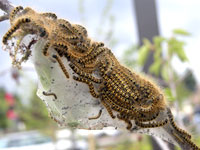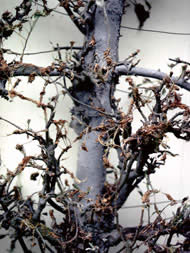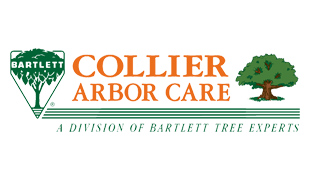|

Tent and larvae of the western tent caterpillar Leaf Feeding CaterpillarsDownload a PDF of this articleDescriptionThe adults are typically nondescript moths. Only the larvae stage is damaging. Because there are many different species of leaf feeding caterpillars they vary in size, shape and coloration. The larvae will have six legs and are typically yellow or green. In the case of tent making caterpillars they are hairy, yellow-brown with rows of blue and orange spots on the body. Plants AffectedMany species of fruit, native and ornamental trees are affected including; apple, pear, cherry, plum, walnut, rose, privet, oak, alder, willow, dogwood. Symptoms/DamageThe larvae will spin a light web and roll the leaf leaving a distorted and unsightly appearance to the plant. If the insect population is high, part or the entire canopy can be defoliated causing great stress to the plant. Tent making caterpillars will spin large webs or tents and feed on leaves inside. Life CycleLeaf rollers will overwinter as immature larvae protected by a cocoon or as eggs, depending on the species. Cocoons and eggs can be found in bark crevices or beneath bud scales. In spring, the larvae emerge from either their cocoon or egg, migrate to leaves or fruit and begin to feed. Once mature, the larvae select a leaf and construct a shelter by rolling it up using a silken material. Within this structure, the larvae will feed for a number of weeks then pupate and eventually emerge as adults. The adults mate and lay eggs that will overwinter until next spring or the eggs will hatch creating a second generation. The second generation only reaches the larval stage by winter. These larvae overwinter in cocoons. We have two species of tent making caterpillars; the western tent caterpillar larvae hatch in the spring and the fall webworm emerges to feed in the summer months. ManagementCulturalTents may be cut out and destroyed. Biological Parasitic wasps and flies OrganicPyrethrins and neem oil can provide good control. ChemicalApproved insecticides can be used when populations are high. The best time for control is in the early spring during leaf expansion. |

Apple tree with leaf roller damage |
|
Home |
Services |
The Arbor Advisor |
Garden Calendar |
About Us |
Fact Sheets |
Contact Us |
Site Map Collier Arbor Care Portland 503-722-7267 Vancouver (360) 693-6056 Site contents and design ©2013 Collier Arbor Care |





